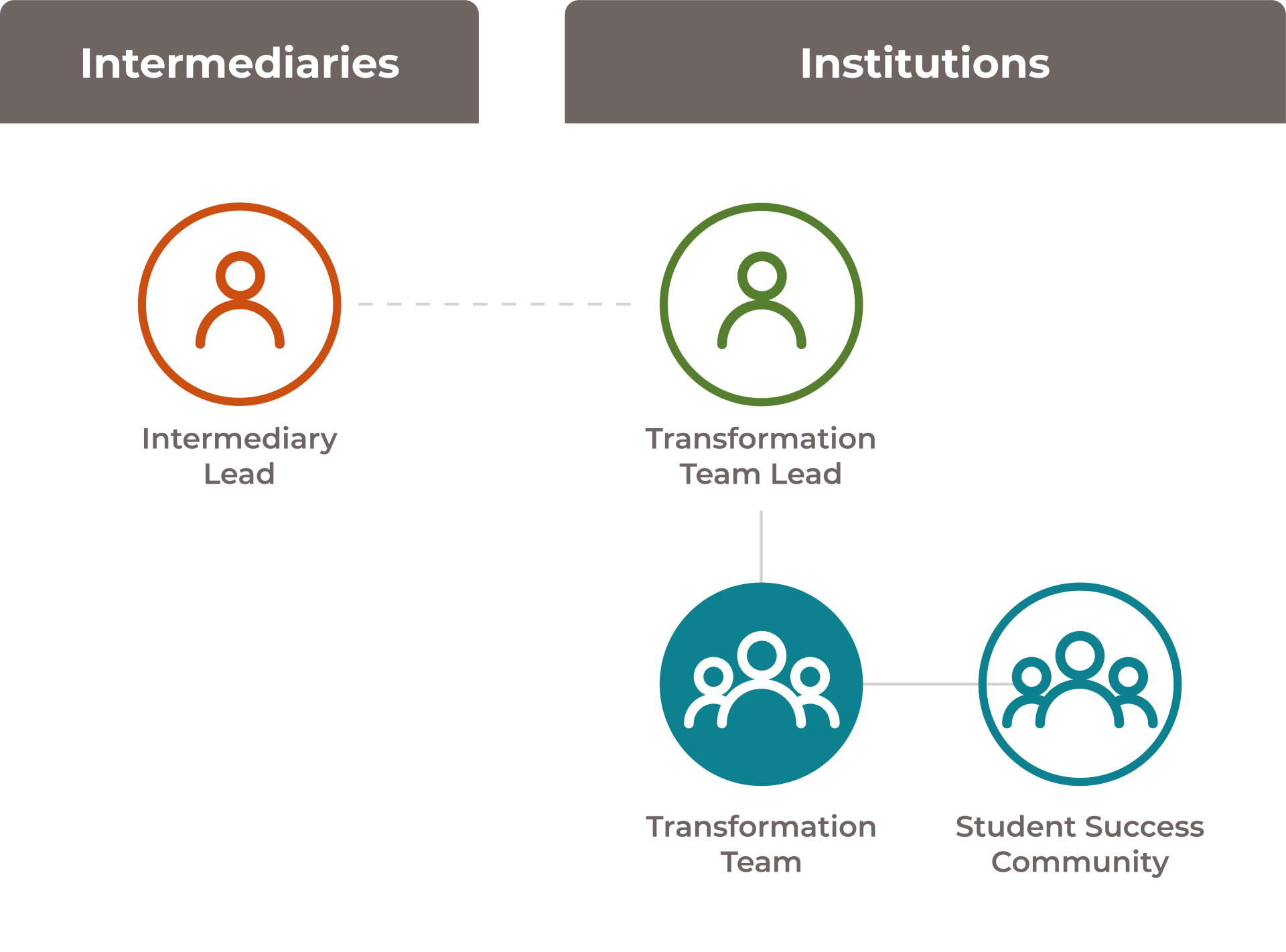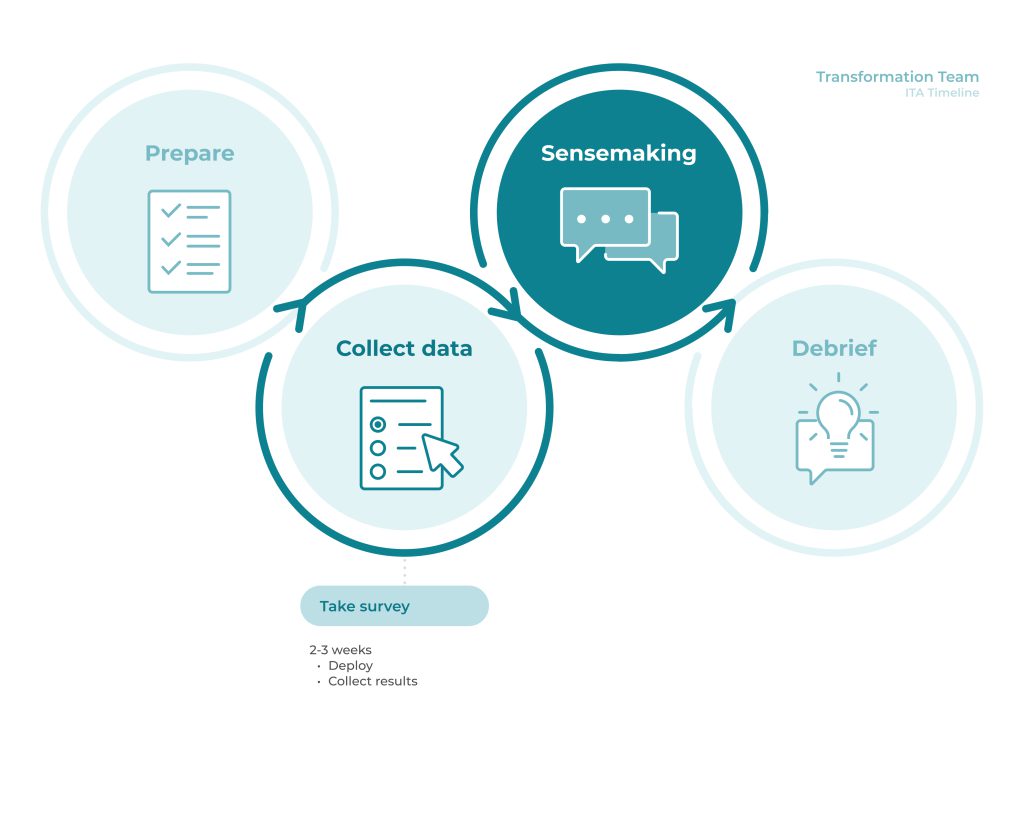Transformation Team
As a Transformation Team participant, you are part of a small group of campus leaders who lead or manage work in at least one of the ITA topic areas, who will take the survey and participate in the resulting Sensemaking Conversation. Your participation contributes to a method that builds on the shared values of institutions working to narrow attainment gaps and improve student outcomes.
- Overview
- Collect data
- Sensemaking
Overview
Reflection and Sensemaking
The Institutional Transformation Assessment (ITA) is a process to help postsecondary institutions reflect on existing student success efforts and the organizational structures that support them. It helps an institution learn more about its areas of strength and improvement, which are a critical input to prioritizing and planning further action to enhance equitable student success. It’s structured around eleven transformation categories, which are organized by a framework including pathways, solutions, and institutional capacities.
The ITA is about reflection and Sensemaking — it is not intended to be evaluative. It’s an organized way to discover how stakeholders from across campuses see their institution.
The collective responses of the team members to the ITA survey are designed to inform a structured Sensemaking Conversation among key leaders at the institution and to fuel a deep and effective discussion around priorities and next steps. During the conversation, you and your colleagues will reflect on the outputs from the ITA (summarized in a dashboard) as well as other sources of information, such as key performance indicators and student success metrics. It’s important to include student-level data and other quantitative inputs in this discussion to help accurately reflect the capabilities of the institution and all the work that has been done to advance equitable student success on campus.
Reviewing the ITA results, particularly in areas where there was a large divergence in answers, is the cornerstone of the Sensemaking Conversation. From there, the team should work to identify what’s next in making progress toward student success goals, ultimately landing on actionable next steps that enhance current activities or point to new or consolidated student success-focused initiatives. This structured opportunity for a diverse group of leaders to come together to have open and candid conversation is the most valuable part of using this method.
As you work within your institution to improve the student journey and student outcomes, it’s helpful to have tools to spur reflection and conversation. Likely you’re already on the road to transforming with a focus on student success and equity—the ITA rubrics and Sensemaking Conversation can help you have more actionable conversations that lead to new insight.
Your role as a Transformation Team participant
As part of the Transformation Team, a small group of leaders who lead or manage work in at least one of the ITA topic areas, you will:
- Take the full ITA survey
- Participate in the Sensemaking Conversation
You and your team are on a journey of continuous improvement. Maybe you’re far along the path, maybe at the start, or maybe even facing a crossroad—and you’re looking for guidance, collaboration, and inspiration.
No matter where you and your colleagues are in your journey to improve equitable student success on your campus, this method can help support deeper reflection via a structured conversation that builds off of a perception-gathering assessment, as well as other inputs. It builds upon the shared values of institutional leaders working to narrow attainment gaps and to improve student outcomes, and centers on the power of gathering together to have a new kind of conversation about transforming for student success.
The Institutional Transformation Assessment (ITA) was built on a foundation of rubrics, created by experts, that represent current standards in a range of solution areas and operating capacities. The rubrics offer a common language to help align and orient teams to standards. It’s important to know that the ITA is not intended to be evaluative; rather, it’s designed to assess perceptions in order to support and streamline reflection. That reflection comes in the form of a dynamic Sensemaking Conversation—the centerpiece of this method. The conversation is grounded in the results of the ITA survey and structured around the consideration of those results by both the facilitator and participants. Ultimately, the conversation provides a forum for a varied group of leaders from across an institution to come together to reflect and plan.
Support materials
Resources for participating in the Institutional Transformation Assessment and Sensemaking Conversation.
Your timeline
The ITA supports institutional transformation – a continuous improvement process – by enabling efficient and effective conversations about efforts related to student success.
Expect the following amount of time to be required for each activity at the institutional level:
- ITA : 2–3 weeks for all participants to take the assessment.
- Intermediary and Transformation Team Lead review of ITA results: At least 2–3 weeks
- Sense-Making Conversation: The conversation itself can be one 4–5 hour meeting, multiple 2 hour meetings, or whatever works best for schedules.
Collect data
Taking the ITA survey
Download and follow the ITA checklist for some key steps to participating in the ITA process at an institution.
Taking the ITA
Research has determined that focusing on the broad set of topics comprising the ITA rubrics at the same time is likely to yield a more effective, faster path to an institution’s transformation towards improving student success.
The cross-functional part of this work where each team member is aware of each other’s role and contributions to transformation is critical. The core idea of the ITA is that people from all different functional specialties and groups converge on this one survey together.
There are topic areas that you may have a strong, working familiarity with and some that are completely unfamiliar. This is okay! Responding with “I don’t know” to these unfamiliar questions is perfectly fine. Completing the entire survey across all topic areas can lead to valuable realizations where people can see connections between their work and the work others lead. This builds awareness of areas that seem unrelated but often have a lot of intersection.
Even if you come across a topic that you have zero familiarity with and isn’t something you engage with day to day, by participating in the survey and really examining the content, you are able to better participate and understand what’s being discussed during the Sensemaking Conversation so that a more unified approach can be realized.
ITA Links
You will receive a registration link specific to the Transformation Team survey from your Team Lead that was created uniquely for your institution. Plan to take 45-60 minutes to complete the survey and know that it’s not required that you complete it all at once.
Returning to the Institutional Transformation Assessment:
If you do not complete the ITA survey in one sitting, you are able to return and pick up where you left off.
To do so, you’ll need to use the Return to ITA link, which was included in the original invitation email that you received. Alternatively, you can use the link in the Return to ITA email that was automatically sent to you after you registered for the ITA (make sure to check your spam folder if you don’t see it in your inbox—email subject is “ITA Return Link,” sent from itaAdmin@qemailserver.com).
It’s important to use the Return to ITA link and not the original registration link in the invite email. Using the registration link to return to your partially completed survey will cause a “duplicate panel member” error because the ITA will assume you are registering again.
If you receive this error, you have two options:
- You may alert your team lead to the error and they can clear the duplicate profile. (Be aware that this may take 24-48 hours.)
- You may click on the original registration link again, but you will need to use a different email address and take the survey from the beginning again. Please note that any progress made with your original login will be lost.
Staying involved
Everyone participating in, facilitating or administering the ITA survey has a valuable role in contributing to a productive Sensemaking Conversation. As part of the Transformation Team, you will participate in the ITA survey and Sensemaking Conversation, which digs deep and connects the dots between departments and efforts to reach new insights that can spur action. The goal is to learn about each other’s perceptions and come to consensus on prioritized next steps.
Sensemaking
Participating in a Sensemaking Conversation
You can help ensure that the Sensemaking Conversation is deep, dynamic, and useful by arriving prepared to have an open discussion with your peers.
Use the conversation checklist to learn about a few things you can do to prepare.
The Sensemaking Conversation
Continuous improvement relies on effective, open dialogue. This conversation provides a structure to dig in and make sense of the ITA outputs as you collectively reflect on your institution’s current state and prioritize actionable next steps.
This conversation brings together leaders from areas across campus to exchange insight and ideas. The goal is to reflect on and discuss your institution’s current state, and where you see opportunity to take action.
ITA outputs inform this conversation, as well as other resources such as student-level data, PDPs, institutional data, strategic priorities, or ideas from other institutions or support providers. When participants arrive prepared after reflecting individually, the conversation builds from a discussion of your institution’s current state to a forward-looking conversation about what’s next in making progress toward your student success goals.
Because no two institutions look exactly alike, and no two work to improve in exactly the same way, the ITA process is intended to flex to fit into your existing work, whether you are using the ITA for the first time to check on progress, or if it’s already a part of your annual strategic planning process. Your facilitator will guide you through your institution’s unique approach to the conversation.
Ideally, this conversation will help your team develop a habit of more effective, efficient conversations. You’re already immersed in this work, but this structure can help teams come together in a fresh way and get to focused action faster.
Reflections from previous participants
“I hope that immediately our thinking is informed by this. I hope that [in] everything we do moving forward … we see this as data. We should quote from it liberally, we should rely on it, we should use it as one of our building blocks.”
Dean of Science and Math
“It was useful to see where the … team had the greatest variance in scores. It highlighted areas that need more inter-departmental communication so as to create shared meaning around various metrics.”
VP of Institutional Advancement
“Just getting together in a small but diverse group helped identify what pockets around campus have information and which do not. This really emphasized our need for better communication across campus.”
Transformation Core Team Member

